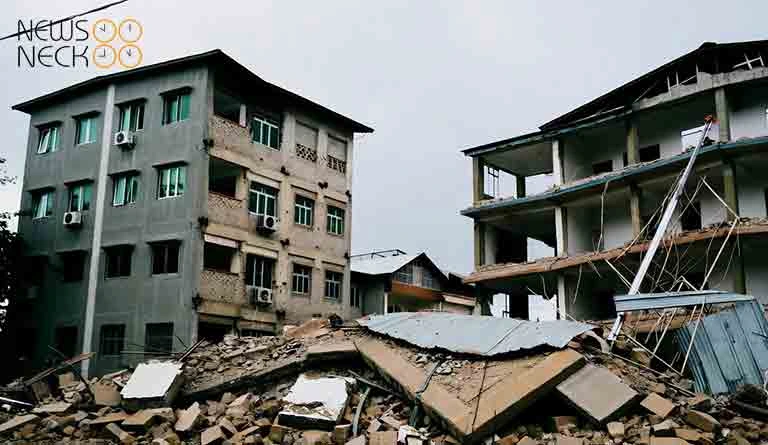Aftershocks and Anxiety: Philippines Powerful Earthquake and Tsunami Scare
In the coastal communities of the southern Philippines, a familiar fear returned with violent force on Friday. A magnitude 7.4 earthquake struck off the coast of Mindanao, killing at least two people, damaging buildings, and triggering a desperate race to higher ground as tsunami warnings echoed across the region.
MANILA, Philippines — Jun Saavedra was driving his car when the world began to sway. Power lines whipped wildly above him. The ground shook so violently that people darted from houses and buildings as electricity cut out across the town.
“We’ve had earthquakes in the past, but this was the strongest,” said Saavedra, a disaster-mitigation officer in Governor Generoso town, Davao Oriental. His community, located about 100 kilometers south of the epicenter, experienced intense ground shaking that left cracks in several buildings, including a local high school.
The powerful 7.4 magnitude earthquake struck off the southern Philippines at 9:43 a.m. local time on Friday, sowing panic through coastal communities and triggering a tsunami alert that sent thousands fleeing. The quake, which occurred at a depth of 23 kilometers (14 miles) in the volatile Philippine Trench, killed at least two people and forced the evacuation of approximately 250 patients from a damaged hospital.
The Human Toll
The earthquake’s impact was both physical and deeply personal. The two victims died after being pinned in damaged houses in Davao Oriental province. In the same province, about 50 high school students were brought to hospital by ambulance after fainting or becoming dizzy during the violent tremors.
Richie Diuyen, a disaster official in Manay town near the epicenter, said the quake lasted for 30-40 seconds and damaged houses, roads, bridges, and the facade of a church.
“I am 46 years old now, and this is the strongest earthquake I ever felt,” Diuyen told Reuters. “The damage is quite big”.
The quake’s force was felt across the region. Christine Sierte, a teacher in the town of Compostela, was in an online meeting when the violent shaking started.
“It was very slow at first then it got stronger … that’s the longest time of my life. We weren’t able to walk out of the building immediately because the shaking was so strong,” she said. “The ceilings of some offices fell, but luckily no one was injured”.
Tsunami Warning and Coastal Evacuations
Within minutes of the quake, the Philippine Institute of Volcanology and Seismology (Phivolcs) issued a stern warning: a destructive tsunami with “life threatening wave heights” was expected. The agency strongly advised residents in coastal communities across seven provinces to “immediately evacuate to higher grounds or move farther inland”.
The U.S. Tsunami Warning System initially warned of possible hazardous waves for coasts within 300 kilometers (186 miles) of the epicenter, with projections of waves up to 3 meters (10 feet) possible on some Philippine coasts.
The panic was palpable. Video feeds from a market in Davao showed the ground shaking violently as people screamed and took cover. In Davao City, firefighters were filmed crouching on the ground outside their station as sirens blared.
Jaymar Seso was outside the Davao Regional Medical Center when the tremors began. “All the people in the building came out shouting loudly,” he told CNN. “After it subsided, you could really see the fear on people’s faces”.
A Nation Weary of Disaster
For the Philippines, Friday’s quake represents the latest in a punishing series of natural disasters. The tremor comes less than two weeks after a 6.9 magnitude earthquake struck the central island of Cebu, killing at least 74 people in the country’s deadliest quake in over a decade.
“The Filipinos are now experiencing disaster fatigue from typhoons, volcanic minor eruptions and earthquakes,” Dr. Teresito Bacolcol, director of the Philippine volcanic agency Phivolcs, said in a media conference on Friday.
The Philippines sits on the geologically unstable “Ring of Fire,” a 25,000-mile (40,000-kilometer) arc of seismic fault lines around the Pacific Ocean that’s home to more than half of the world’s volcanoes. The country experiences more than 800 quakes each year.
John Dale B Dianala, a geology professor at the University of the Philippines, explained that the nation’s location makes it particularly vulnerable.
“The whole length of the Philippines, around 1,800km, is right along the boundary of two major tectonic plates – the Philippine Sea plate and Eurasian plate,” he told Al Jazeera. “When the displacement involves vertical uplift of the seafloor from an offshore fault, like in the Philippine Trench to the east of the country, the movement displaces the water column… in the form of tsunamis”.
The Response and a Sigh of Relief
President Ferdinand Marcos Jr., facing yet another natural disaster after recent earthquakes and back-to-back storms, said the government was assessing the situation and preparing search and rescue operations.
“I have directed the National Disaster Risk Reduction and Management Council, the Office of Civil Defense, the Armed Forces, the Philippine Coast Guard, and all concerned agencies to immediately carry out evacuations in coastal areas, activate emergency communication lines, and coordinate closely with local governments,” Marcos said.
The international airport in Davao City sustained cracks in its walls but remained operational without any flights cancelled. Schools across the region were shuttered to allow for damage assessments.
Then, about two hours after the initial quake, came welcome news: the Pacific Tsunami Warning Center in Honolulu declared the tsunami threat had passed. While small sea fluctuations might continue, the danger of destructive waves had diminished.
Small tsunami waves were detected on the Indonesian and Philippine coasts, with the highest reaching just 17 centimeters (6.7 inches) in Indonesia’s North Sulawesi province. The tsunami warnings were lifted in both the Philippines and Indonesia.
You Might Like it: Israel-Gaza Peace Talks
An Uncertain Recovery
As Friday wore on, aftershocks continued to rattle the southern region of Mindanao, a reminder that the earth beneath remains unstable. The psychological tremors may last even longer in a population growing weary of nature’s wrath.
Dr. Bacolcol offered a sobering perspective to his fellow Filipinos, urging not panic but preparation. “Instead of panicking, we have to prepare,” he said. “Accept our reality that every now and then we will be jolted by earthquakes, volcanic eruptions and tsunamis”.
For communities like Jun Saavedra’s, the recovery is just beginning. The cracks in buildings will need inspection, the frightened children will need comfort, and the collective nerve of a nation tested once again will need steadying.
As the sun set on a day that began with terror, the people of the southern Philippines were left counting their blessings—the waves that never came, the buildings that held firm, the lives narrowly spared—even as they mourned the two neighbors who would not return home.
This story was reported from Manila with contributions from journalists across the Mindanao region.
Author: Junaid Arif
Date: 10 Oct, 2025
For More Updates, Visit Newsneck













